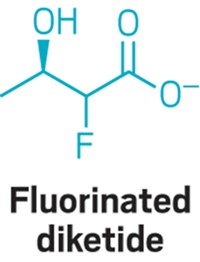Advertisement
Grab your lab coat. Let's get started
Welcome!
Welcome!
Create an account below to get 6 C&EN articles per month, receive newsletters and more - all free.
It seems this is your first time logging in online. Please enter the following information to continue.
As an ACS member you automatically get access to this site. All we need is few more details to create your reading experience.
Not you? Sign in with a different account.
Not you? Sign in with a different account.
ERROR 1
ERROR 1
ERROR 2
ERROR 2
ERROR 2
ERROR 2
ERROR 2
Password and Confirm password must match.
If you have an ACS member number, please enter it here so we can link this account to your membership. (optional)
ERROR 2
ACS values your privacy. By submitting your information, you are gaining access to C&EN and subscribing to our weekly newsletter. We use the information you provide to make your reading experience better, and we will never sell your data to third party members.
Synthesis
Fluorine Biosynthesis Unfolds
Enzymes are harnessed to produce fluorinated polyketides, expanding options for synthesizing bioactive fluorinated compounds
by Jyllian Kemsley
September 9, 2013
| A version of this story appeared in
Volume 91, Issue 36
Bioactive fluorinated compounds are highly desired as pharmaceuticals and agrochemicals. But the very properties of fluorine that allow it to enhance the desired reactivities of these classes of compounds also make it difficult to work with synthetically. And only one organofluorine biosynthetic pathway is known: the fluoroacetate pathway in the soil bacterium Streptomyces cattleya. A team led by Michelle C. Y. Chang of the University of California, Berkeley, has now identified other biosynthetic pathways that can incorporate fluorine into polyketides, a broad class of natural products with antibiotic, antiparasitic, insecticidal, and other functions (Science 2013, DOI: 10.1126/science.1242345). Although the enzymes normally don’t process fluorinated compounds, they have enough substrate flexibility to do so. Working both in vitro and in vivo with engineered Escherichia coli, Chang and colleagues used enzymes from polyketide synthase systems to go from fluoroacetate to polyketide lactones with fluorine site-selectively incorporated into the polyketide backbone.





Join the conversation
Contact the reporter
Submit a Letter to the Editor for publication
Engage with us on Twitter